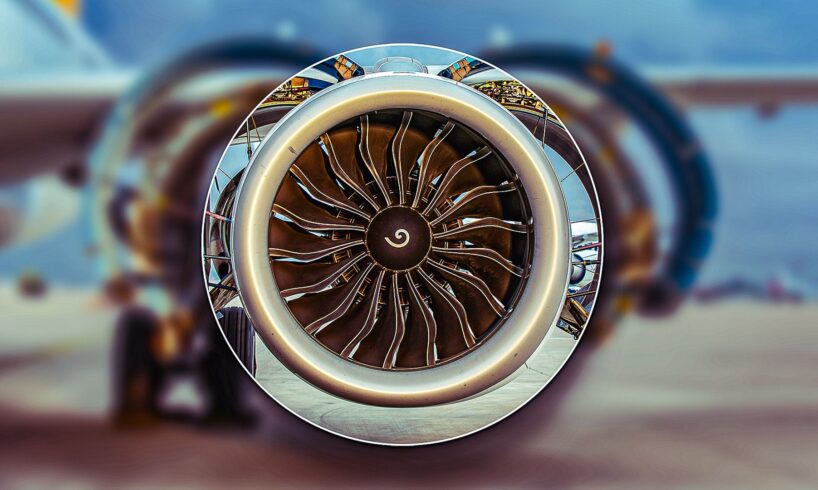
The Pratt & Whitney PW1100G, a variant of the engine series marketed as the P&W GTF, used on the A320neo, has received a further update, the GTF Advantage (GTF-A). This engine was announced in December 2021, with the manufacturer claiming it to have better fuel efficiency, durability, and the ability to deliver high thrust at hot and high-altitude airports.
Business Type
Engine Maker
Date Founded
January 1, 1925
CEO
Christopher Calio
Headquarters Location
East Hartford, United States
This article explores the major differences between the GTF series and the GTF-A, as well as the methods used to achieve these distinctions. It then examines when the GTF-A will enter service and the pitfalls experienced by the PW1100G that will need to be avoided. What will become clear is that the GTF-A is not a radically different engine. Rather, it is an improvement that offers P&W the chance to wipe the slate clean after multiple issues with the PW1100G.
What Are The Key Differences?
Photo: Bene Riobó | Wikimedia Commons
The GTF-A builds on the GTF series, which already offers the lowest fuel consumption for single-aisle aircraft. The GTF-A offers even greater fuel efficiency, with claims of a 1% improvement. Tom Pelland, the company’s GTF chief engineer, claims that the engine will have 8% greater thrust at hot and high airports, and 4% better thrust at sea level. Engines often struggle in these conditions that cause reduced air pressure. It also builds on the successful testing of sustainable aviation fuel (SAF) on the GTF series, with Pratt & Whitney aiming for the engine to be 100% SAF compatible. The improvements will enable airlines to fly longer, carry higher payloads, and have a reduced environmental impact.
Pratt & Whitney has achieved this progression on an already successful engine through several advancements. The company’s engineers have increased core airflow by optimizing the active clearance control between the turbine and seals, lowered the high-pressure compressor temperatures, and used more durable coatings and blisk rotors.
Risk Deurloo, President of Commercial Engines for Pratt & Whitney, commented on what these advancements will mean for the aviation industry. He said:
“GTF engines already offer the lowest fuel consumption and CO 2 emissions for single-aisle aircraft. The GTF Advantage engine extends that lead and enhances aircraft capability, providing more thrust and even more value to operators of A320neo family aircraft, especially on longer-range aircraft like the A321XLR, all with a more durable configuration.”
The GTF-A also emerges from a different context than the original GTF turbofan. The original GTF brought new geared technology to the commercial aviation industry. This ground has already been broken for the GTF-A. Engineers were able to use 100,000 hours of engine and rig testing across the GTF family and 40 million flight hours to develop an improved engine.
Why Was The P&W GTF So Revolutionary?
Photo: Bin im Garten | Wikimedia Commons
In most cases, a turbofan’s turbine and fan rotate at the same speed. The PW1000G family bucks this trend as a geared turbofan, a design decision shared with the GTF-A engine. A geared turbofan is fitted with a gearbox, allowing the turbine and fan to rotate at different and optimum speeds. This brings advantages in terms of fuel consumption and reduced noise pollution.
This technology was not entirely new with the P&W GTF. Turbomeca Aspin developed small-geared turbofans in the 1950s, and the Garrett TFE731 and Lycoming ALF 502 engines went into production in the 1970s. However, the idea didn’t catch on due to concerns about weight and reliability. General Electric and Safran opted not to use geared technology when developing the CFM LEAP family for this reason.
The table below outlines the key specifications of the PW1100G. This is the engine from the P&W GTF family that the GTF-A is most closely derived from:
Fan diameter
81 in (206 cm)
Bypass ratio
12.5:1
Static thrust
24,000-35,000 lbf (110-160 kN)
Application
A320neo family
Service entry
25 January 2016
Weight
6,300 lb (2,858 kg)
Takeoff thrust-to-weight ratio
3.85 – 5.26
Max fan speed
3,281 rpm
The successful use of geared technology by Pratt & Whitney has inspired some other manufacturers to develop geared turbofans. Rolls-Royce has been developing its UltraFan since 2016. The scaled-down UltraFan 30 is a clear competitor to the PW1100G. It is designed for single-aisle aircraft, generating 30,000 lbf (130 kN) of thrust. The manufacturer plans to run this engine by 2028.
Related
Rolls-Royce Completes 1st Ultrafan Technology Demonstrator Tests
This technology offers a 10% efficiency improvement over the Trent XWB engine.
Powering The Same Aircraft
Photo: LMP 2001 | WIkimedia Commons
As well as using the same propulsion methodology, the GTF-A will also power the same aircraft family: the A320neo. The engine will compete with the CFM International LEAP-1A and attempt to make a stronger case for geared turbofans.
If it can be reliable, the GTF-A will be an enticing option for A320neo customers. This jet was designed to be 15-20% more efficient than previous models, demonstrating a clear alignment in missions. The table below details the A320neo’s specifications. Although the A320neo family includes the A319neo, A320neo, A321neo, A321LR, and A321XLR, all of which have the PW1100G as an engine option, the table consists of data for the A320neo itself:
Two-class capacity
165
Wingspan
117ft 5 in (35.8 m)
Maximum takeoff weight
174,200 lb (79 tons)
Fuel capacity
7,835 US gal (26,659 l)
Cruising speed
Mach 0.78 (450 knots)
Typical range
3,500 nautical miles (6,500 km)
Ceiling
39,100–39,800 ft (11,900–12,100 m)
The GTF-A is also likely to reach the thousands of orders achieved by the PW1100G. As of May 2025, 3,954 A320neo jets have been built, but thousands more are still to come. Airbus has achieved a total of 11,128 A320neo orders.
When Will The GTF-A Enter Service?
Photo: Don-vip | Wikimedia Commons
The GTF-A has achieved US Federal Aviation Administration (FAA) certification, and deliveries are expected to begin later in 2025. The announcement came a week after another announcement of the A321XLR with GTF engines receiving type certification from the European Union Safety Agency (EASA).
In February 2025, when this announcement was made, over 2,200 GTF-powered aircraft had been delivered to 80 customers worldwide. These engines improved fuel efficiency by 20% and saved over 2 billion gallons of fuel. Airlines flying with GTF turbofans have reduced their CO2 output by 20 million metric tons. The engine also remained popular despite groundings and reliability issues, and the company had 11,000 engine orders and commitments across the GTF family.
Deurloo, President of Commercial Engines for Pratt & Whitney, commented on the significance of the certifications for the company’s storied history. He said:
“With this certification and engine deliveries on track for later this year, it’s fitting we mark these milestones in 2025, as Pratt & Whitney celebrates a century of powering the future.”
P&W Will Want To Avoid Replicating The PW1100G’s Failures
Photo: BriYYZ | WIkimedia Commons
The P&W GTF has had some concerning failures. The manufacturer will want to avoid these problems resurfacing once it launches the GTF-A. Ongoing issues with specific engine parts led RTX, P&W’s parent company, to announce that it will be removing 600–700 engines between 2023 and 2026. This was set to require 350 aircraft to be grounded, with a turnaround time of 250-300 days for each jet. The manufacturer would have to remove and reinstall each engine on the wing. Neil Mitchill, RTX’s chief, stated that the company would pay out $1 billion in credits for grounded aircraft.
The GTF family has also been hit by inflight failures that could have caused serious accidents. The Indian Airline IndiGo reported four in-flight engine stalls during a climb in October 2019. All were traced to problems with the Low-Pressure Turbine (LPT). The Indian Directorate General of Civil Aviation (DGCA) later instructed the airline to replace the engines on 98 of its A320neos.
The PW1500G engines, also geared turbofans, have also faced issues with inflight shutdowns that the GTF-A will need to avoid. These problems were largely with Swiss International Air Lines Airbus A220s. In one case, the engine shut down because a faulty O-ring seal led to a loss of oil pressure. In another incident, a little less than a year later, the engine’s low-pressure compressor disintegrated as the jet climbed to 32,000 ft. The Swiss International Airlines A220-300 had to divert to Paris-Charles de Gaulle.
Related
What’s The Latest With The PW1100G Airbus A320neo Groundings?
Seemingly, a low recovery of the capacity of GTF-powered Airbus A320neo family aircraft is around the corner.
GTF-A Is A Chance To Rewrite The History Of Geared Turbofans
Photo: LMP 2001 | WIkimedia Commons
In developing the PW1000G family of geared turbofans, Pratt & Whitney aimed to set a new standard of efficiency for the aviation industry. It has achieved this, but only when the engines have been operational. CFM International’s concerns about the reliability of geared turbofans may have been vindicated due to the P&W GTF family’s groundings and in-flight shutdowns. It is noteworthy that other engine manufacturers haven’t clamored to produce geared turbofans.
To some, the GTF-A could represent more of the same. It will also power the A320neo family and offer improvements of a few percentage points across several key metrics. Yet, the GTF-A is also a chance to wipe the slate clean. If this engine can reliably deliver the advantages it offers, other manufacturers will have to take notice.






